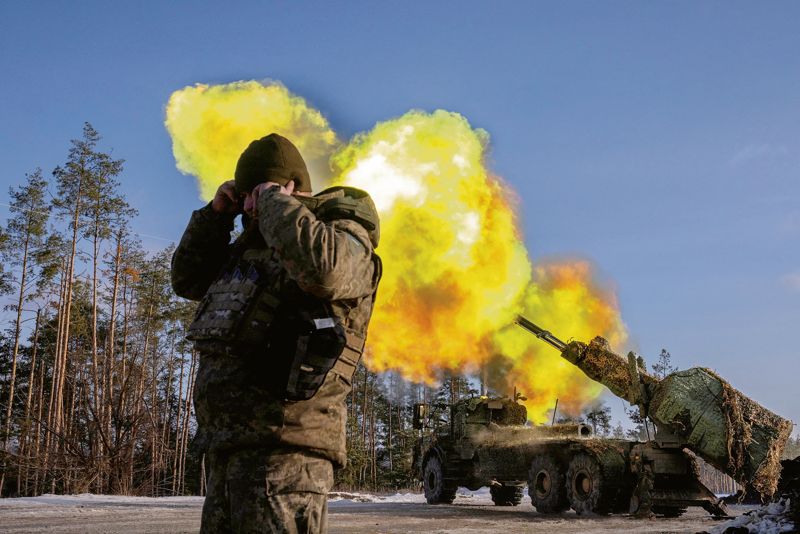Russia beset by losses despite advantage in terms of industrial capabilities and population


SIX months into its counter-offensive, Ukraine has managed to advance just 17 km. Russia fought for 10 months around Bakhmut in the east last year to advance about 6 km. The commander-in-chief of Ukraine’s armed forces, Gen Valery Zaluzhny, in an interview to The Economist last month, observed that like in World War I, “we have reached the level of technology that puts us into a stalemate.” The General’s view is that you would need a huge technology breakthrough to change things.
Ukraine claims that half of Russian artillery and a third of its armoured vehicles have been destroyed by drones.
When the Ukraine counter-offensive began in June, there were expectations that a breakthrough would demonstrate to Russia that the war could not be won. Instead, last week, an emboldened and confident Russian President Vladimir Putin said at a news conference in Moscow that there would be no peace till Russian goals of “de-Nazification, de-militarisation and a neutral status” of Ukraine were met.
Zaluzhny said his thesis had been borne out by the fate of the most recent Russian ‘counter-counter-offensive’ aimed at Avdiivka in eastern Ukraine, where the Russians have been able to advance barely a few hundred metres despite throwing in a vast number of troops in the past month. The combination of artillery, mines and First Person View (FPV) drones made the frontline lethal for both the Russians and the Ukrainians.
The General’s belief is that the technological shift will not be in the form of a single technology, but in a combination of them — drones, electronic warfare (EW), counter-artillery systems, demining systems and robotics.
Artillery remains the queen of battle. It has caused the maximum casualties, but for point targets, drones are increasing their share. The war has also demonstrated some old features — for example, the importance of digging trench systems and tunnelling.
The Russians did not do this well to start with; now, by some accounting, they are better than the Ukrainians. In Avdiivka, the Russians have even used the medieval technique of mining under Ukrainian positions and setting off explosives.
Ukraine claims that half of Russian artillery and a third of its armoured vehicles have been destroyed by drones. Ukraine pioneered the use of the FPV drones, where the craft’s view is seen through the operator’s video goggles and it has real-time manoeuvrability. The drones are inexpensive but can carry enough explosives to destroy a tank, an artillery gun or a vehicle.
Ukraine initially enjoyed total dominance in this new class of drones, but the Russians have caught up. The first Russian FPV drones appeared only by July, but they are now posing a major challenge to Ukrainian units.
Russia has clear superiority when it comes to the more expensive classes of drones, such as high-powered reconnaissance machines. They have also begun equipping their tanks and artillery with jamming systems to foil the guidance system of drones. They also use EW systems which scramble the guidance system or jam radio control links.
The Russian UAVs are deployed in three layers, with the modified Orlans, which can now fly in any weather, operating at around 2,000 metres to monitor the battlefield and emit electronic counter-measures.
Smaller drones fly closer to the Ukrainians and spot artillery. Finally, FPVs are used for attack purposes: some are deployed to attack field fortifications, others roam the battlefield and target Ukrainian vehicles. What has been noticed is the Russian ability to coordinate their drone fleet well.
Russian success in drone warfare is partly also explained by the density of EW systems it is able to field, thanks to years of investment in this area. Ukraine found in early March that its Western-supplied Excalibur GPS-guided shells started going off target due to Russian jamming; similar problems have appeared with the US-supplied JDAM-ER aerial bombs and HIMARS-launched GMLRS long-range rockets.
Ukraine depended on Russian-origin EW systems, but is now fielding its own products that can spoof satellite-based navigation systems. Ukrainians are also adapting various home-grown solutions to existing systems and have become a leader in counter-drone systems. They are using battlefield robotic systems and carrying out a range of innovations that are seeing the deployment of AI-assisted autonomous systems and drones. Fully autonomous weapons systems could be fielded in the coming year and this would be an innovation that is likely to have a lasting impact on militaries around the world.
The Western allies have not been very helpful in the EW area since this is seen as a technology they would not like to fall into the hands of the Russians. They continue to maintain strict technology export controls here. But there is no reason why the West cannot get into joint technology development to aid Ukraine and also benefit from the enormous amount of innovation unleashed by the war.
As of now, with technology creating a stalemate, this has become a war of attrition, very much like World War I.
The Russian materiel and troop losses are huge and the Ukrainians have no choice but to keep fighting until those losses change Russian behaviour. This is not very different from what happened in Afghanistan and Vietnam.
Russia has an advantage in terms of its industrial capabilities and population base. But the war is weighted in favour of Ukraine, which is fighting for its own territory. It is, however, frustrated that Western assistance has been slow and fitful. And now it is wavering due to domestic political pressures in both Europe and the US. This has encouraged a new and hardened Russian stance.
